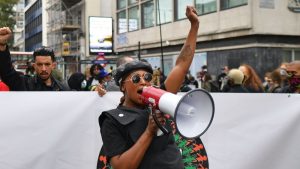
The law many protesters at Occupy Oakland have been arrested under, CA Penal Code Section 647c, is a copycat of a Birmingham, Alabama vagrancy law that was used against African American civil rights activists in the 1960′s. The law was written to prevent civil rights activists from assembling in to protest racial discrimination. It is being used for similar purposes in Oakland in 2012.
California Penal Code Section 647c states that every “person who willfully and maliciously obstructs the free movement of any person on any street, sidewalk, or other public place or on or in any place open to the public is guilty of a misdemeanor.” Section 647 as a whole embraces a variety of offenses under the general catch-all of “disorderly conduct.” The section was originally drafted as a vagrancy statute, and as recently as 1955 was titled “Vagrancy, definitions; punishment.”
While 647c is couched in this broader context of “disorderly conduct” and vagrancy laws more generally, it seems that it might have been written with a more politically motivated agenda. In a case called Jennings v. Superior Court, the Court of Appeals of California for the First Appellate District posited that 647c, enacted in 1967, may have been a result of the United States Supreme Court decision in Shuttlesworth v. City of Birmingham. (Jennings v. Superior Court, 104 Cal. App. 3d 50, at 53 (1980)).
The petitioner in Shuttlesworth v. City of Birmingham (1965) was Reverend Fred Shuttlesworth, the famous civil rights activist who was instrumental in the sit-ins against segregated lunch counters in 1960 and took part in the organization and completion of the Freedom Rides in 1961.
According to the facts of the case as relayed by the Court in Shuttlesworth, Shuttlesworth, the petitioner, was standing in a group of 10-12 people near an intersection when a police officer asked them three times to clear the sidewalk for pedestrian passage. All of those gathered left except for petitioner who questioned the policeman about his order, and was thereby arrested and charged with violating two Birmingham, Alabama ordinances. One of the ordinances closely resembles 647c in that it criminalizes the state of being on a street or sidewalk in a way “as to obstruct free passage.” The other ordinance made it unlawful to refuse to stand or loiter after having been requested by a police officer to move on. (Shuttlesworth v. City of Birmingham 382 U.S. 87, 88 (1965)).
The facts of the case that are not presented in the Court’s opinion are this: the intersection where folks were gathered was in front of a department store, and there was an ongoing boycott of downtown department stores. Interestingly, the Justice who reversed Shuttlesworth’s conviction authored several opinions dealing with loitering arrests occurring at organized protests.
The Shuttlesworth case is a good example of how, starting in the 1960s, law enforcement officers began to use vagrancy laws in a new way: to quiet African Americans engaging in protest and free speech as part of the civil rights movement. As such, the Court of Appeals of California’s suggestion that 647c was enacted as a result of the Shuttlesworth case is quite chilling. The court is positing that the California law was authored with the intent to be used, or at least to be available for use, as a way of criminalizing protest and free speech activities. (Jennings v. Superior Court, at 53.)







